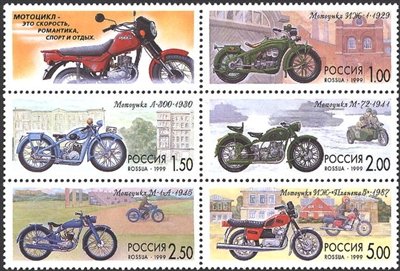09.09.1999
Painter – Bezmenov A.
Stamps per sheet: 24 (2x2 se-tenants of 2x3 stamps).
Paper - coated; manufacturing process - offset; perforation - comb 12 x 12½.
Se-tenant print quantity - 350000.
 |
||
| K1 | 523 |
| 524 | 525 |
| 526 | 527 |
| № | Face value | Size | Description | Price, mint | Price, used |
|---|---|---|---|---|---|
| 523 | 1.00 | 58×26 | IZh-1 motor cycle (1929). The first IZH series motor cycles were created in Izhevsk (Republic of Udmurtia). A team of enthusiast engineers designed and built five test motor cycles of the IZh series which featured many original technical solutions. They carried various engines, sturdy frames with incorporated exhaust tubes. In 1929 the first IZh motor cycles took part in the All-Russian cross-country motor-cycle race and covered more than 3000 km. Izh-2 motor cycle, with a centrifugal engine-cooling system and quiet exhausts, showed the best results. The designers used the experience gained in the race to create the first serial motor cycle at Promet, a Leningrad factory. The Izh-1 specifications include a four-time two-cylinder engine (1200 cub. cm), and max speed of 70 kmph. multicolor | 1.00 | 0.20 |
| 524 | 1.50 | 58×26 | L-300 motor cycle (1930). The first serial Soviet motor cycle produced at Promet, a Leningrad factory. In September 1930 the first 25 motor cycles were produced, eight of them took part in the the All-Russian cross-country motor-cycle race covering the distance of 3212 km. The motor cycle was improved later in 1930. The serial production of motor cycles was established at the Red October plant, and by 1933 its production reached 10,000 items. L-300 is a strong and reliable vehicle which was widely used in the Army for communication and close-range intelligence. It was also used in driving schools for driving lessons. Specifications: a two-time single cylinder engine (300 cub.cm), max speed of 75 kmph. multicolor | 1.50 | 0.30 |
| 525 | 2.00 | 58×26 | M-72 motor cycle (1941). The vehicle was created in 1941 on a military order at the Moscow motor cycle plant, and the first serial motor cycles were produced for the Army later that year. When the nazi troops advanced closer to Moscow the motor cycle production lines were evacuated to Irbit, Sverdlovsk region. As a combat vehicle, the motor cycle was equipped with 7.62mm infantry machine-guns, with a machine-gun bullet box in the boot, an anti-tank grenade box in the side-car, and a bag for the crew's paraphernalia. After the war the Irbit plant continued to produce M-72 motor cycles, and until 1961 a modernised version named M-72-M was also produced. Specifications: a four-time two-cylinder engine (750 cub.cm), max speed 85 kmph. multicolor | 2.00 | 0.40 |
| 526 | 2.50 | 58×26 | M-1-A motor cycle (1945). After the war the new Soviet motor cycles (M-1-A) were produced at the Moscow Motor Plant. Later the production moved to the Motor Cycle Plant in Minsk (MMVZ). The M-1-A model, which was cheap, reliable and easy to drive was very popular among the people, which secured its mass production. In 1950-1970 it was the most popular vehicle in driving schools. Today the motor cycles are still produced in Minsk, including such sales hits as MMVZ-3.1131 and MMVZ-3.11212. Specifications: a two-time single-cylinder engine (125 cubic cm), max speed 70 kmph. multicolor | 2.50 | 0.50 |
| 527 | 5.00 | 58×26 | Izh Planeta-5 Motor cycle (1987). The first serial motor cycle produced at the Izhevsk plant (Izh-350 model). After this model was modernized, the plant started to produce Izh-49, another vehicle of this class. In 7 years Izh-56 appeared. The model was constantly modernised, hence Izh-56K, and Izh-Planeta. In 1987 Izh-Planeta-5 was created, which became a very popular motor cycle, reliable on all kinds of road surfaces. The motor cycle showed good results in long-distance travel up to 3,000 km. Specifications: a two-time single-cylinder engine (346 cubic cm), max speed 120 kmph. multicolor | 5.00 | 1.00 |
Category:
Industry, construction, agriculture, technology : Motor transport
FDC:
no data





